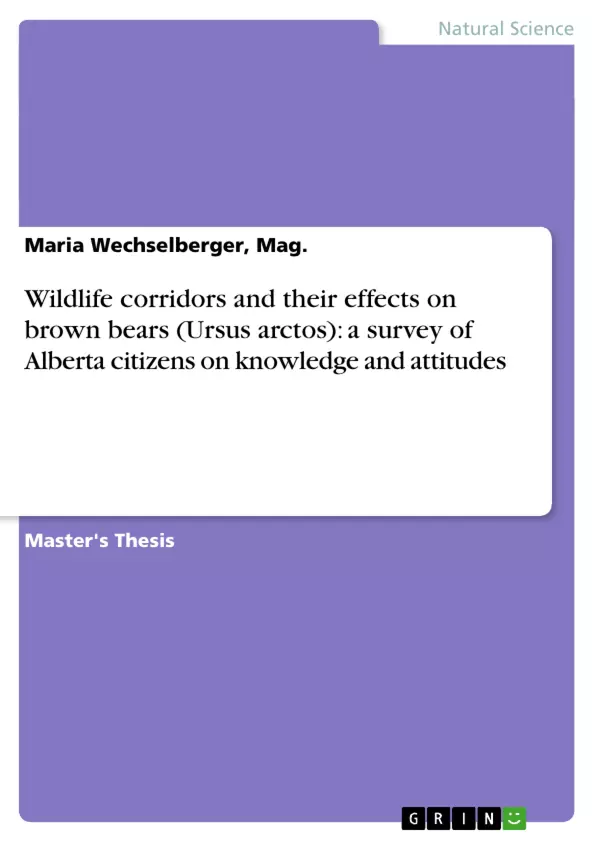“If all the brown bears are gone from the landscape we would be spiritually impoverished.” was the response from a researcher when she was asked why we should protect bears. This is only one of numerous answers to this question.
Bears engage our interest, as do few other wild animals. But brown bears are not simply fascinating animals, they also play an important role in the ecosystem. They are considered 'sustainable farmers'. Many species, both plants and animals, profit by them. Brown bears dig much for food and thereby they stimulate plants to reproduce. Some Canadian scientists even consider grizzlies, conspecific with the Eurasian brown bear, to be an ecological keystone. “Without the grizzlies atop the food chain,” they say, “the West’s delicate mountain ecosystem would crumble.” They think that it could set off a chain reaction that would see other large animals become extinct. Coyotes and other predators would move in and do serious damage to the ungulate population. Grizzlies prey on live ungulates far less than coyotes or wolves. The bears´ presence keeps other predators at bay. Other scientists such as Stephen Herrero, the head of the Eastern Slopes Grizzly Bear Project, do not believe in such dire predictions but Stephen Herrero agrees that the relationship between bears and the rest of the ecosystem is very complex (Sillars 1998).
However, large carnivores, like grizzlies, have been considered indicators of health or integrity of an ecosystem (Paquet and Wierzchowski 1997a) and thus make them useful focal species for large-scale conservation. Landscapes that retain viable populations of brown bears are often ones where natural vegetation predominates, where most native species can still be found, and where ecological processes operate essentially as they have done for a long time (Paquet and Jack Wierzchowski 1997a). Habitats of brown bears can be huge, but vary greatly on individuals. A modest female can manage to live within a few square kilometres, and long distance travellers among grizzlies, that are mostly males, could need up to 1500 km², which is as big as Kootenay National Park in Alberta or only a bit smaller than the Austrian “Hohe Tauern National Park”, the biggest national park in Central Europe.
Table of Content
- INTRODUCTION
- The conservation of brown bears
- The situation of brown bears in Alberta
- History
- Current situation
- Hunting, laws ands compensations - as contributing to brown bear mortality and dispersal
- What do Alberta citizens think about brown bears
- BARRIERS AND WILDLIFE CORRIDORS
- BACKGROUND
- DEFINITIONS
- CONSERVATION THEORY
- TYPES OF CORRIDORS
- Ecological corridors
- Dispersal corridors
- Home range corridors:
- Gene flow corridors
- Gene flow 1
- Gene flow 2
- Gene flow 3
- DESIGNING WILDLIFE CORRIDOR NETWORKS
- Wildlife corridor and habitat patch design
- Regional habitat patches
- Local habitat patches
- Primary or multi-species corridors
- Secondary corridors
- Core areas and multiple use zones
- Stepwise approach to determine shape, size and width of wildlife corridors and habitat patches
- Shape
- Width
- Starting point for wildlife corridor and local habitat patch design
- THE EFFECTS OF ROADS AND OTHER ARTIFICIAL BARRIERS ON BROWN BEARS
- Roads and Railways
- Problem wildlife and habituation
- Mitigation methods
- Overpasses and Underpasses
- Closures
- Education
- THE BOW RIVER VALLEY CORRIDOR
- Closures
- Education
- SURVEY AMONG ALBERTA CITIZENS REGARDING THEIR ATTITUDES TOWARD AND KNOWLEDGE ABOUT BROWN BEARS
Objectives and Key Themes
This study aimed to assess the knowledge and attitudes of Alberta citizens regarding brown bears and their role in the ecosystem. The focus was on exploring the potential impact of wildlife corridors on brown bear populations and the local community's perception of these corridors.
- The conservation status of brown bears in Alberta
- The importance of wildlife corridors for brown bear dispersal and gene flow
- The effects of roads and other artificial barriers on brown bear movement and behavior
- Citizen attitudes toward brown bears, including their perception of risk and potential conflicts
- The role of education and outreach in fostering positive human-bear coexistence
Chapter Summaries
- Introduction: This chapter provides an overview of brown bear conservation in Alberta, outlining historical and current population trends. It examines the role of hunting, laws, and compensation programs in brown bear mortality and dispersal. Additionally, it explores the importance of understanding public attitudes towards brown bears in the context of conservation efforts.
- Barriers and Wildlife Corridors: This chapter explores the concept of wildlife corridors and their importance for connecting isolated populations. It defines different types of corridors, discusses their role in facilitating ecological processes such as gene flow, and examines design principles for effective corridor networks. It further discusses the impact of roads and other artificial barriers on brown bear movement and highlights mitigation strategies such as overpasses and underpasses.
- Survey Among Alberta Citizens Regarding Their Attitudes Toward and Knowledge About Brown Bears: This chapter presents a survey designed to assess the knowledge and attitudes of Alberta citizens towards brown bears. It outlines the methodology, including questionnaire design, sample selection, and data analysis techniques. The chapter provides an overview of the main findings, exploring relationships between socio-demographic factors, knowledge, and attitudes towards bears.
Keywords
Brown bears, wildlife corridors, conservation, Alberta, attitudes, knowledge, human-wildlife conflict, mitigation, roads, overpasses, underpasses, habitat connectivity, gene flow, public perception, education, outreach.
- Quote paper
- Maria Wechselberger, Mag. (Author), 2002, Wildlife corridors and their effects on brown bears (Ursus arctos): a survey of Alberta citizens on knowledge and attitudes, Munich, GRIN Verlag, https://www.hausarbeiten.de/document/16056


